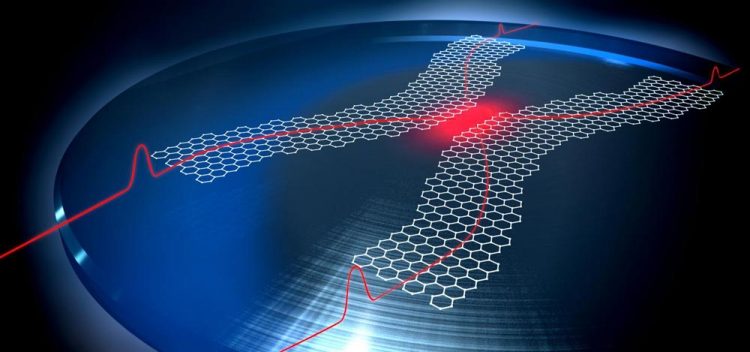Quantum computing with graphene plasmons

Schematic of a graphene-based two-photon gate. Credit: © University of Vienna, created by Thomas Rögelsperger
Photons barely interact with the environment, making them a leading candidate for storing and transmitting quantum information. This same feature makes it especially difficult to manipulate information that is encoded in photons.
In order to build a photonic quantum computer, one photon must change the state of a second. Such a device is called a quantum logic gate, and millions of logic gates will be needed to build a quantum computer.
One way to achieve this is to use a so-called 'nonlinear material' wherein two photons interact within the material. Unfortunately, standard nonlinear materials are far too inefficient to build a quantum logic gate.
It was recently realized that nonlinear interactions can be greatly enhanced by using plasmons. In a plasmon, light is bound to electrons on the surface of the material. These electrons can then help the photons to interact much more strongly. However, plasmons in standard materials decay before the needed quantum effects can take place.
In their new work, the team of scientists led by Prof. Philip Walther at the University of Vienna propose to create plasmons in graphene. This 2D material discovered barely a decade ago consists of a single layer of carbon atoms arranged in a honeycomb structure, and, since its discovery, it has not stopped surprising us.
For this particular purpose, the peculiar configuration of the electrons in graphene leads to both an extremely strong nonlinear interaction and plasmons that live for an exceptionally long time.
In their proposed graphene quantum logic gate, the scientists show that if single plasmons are created in nanoribbons made out of graphene, two plasmons in different nanoribbons can interact through their electric fields. Provided that each plasmon stays in its ribbon multiple gates can be applied to the plasmons which is required for quantum computation.
“We have shown that the strong nonlinear interaction in graphene makes it impossible for two plasmons to hop into the same ribbon” confirms Irati Alonso Calafell, first-author of this work.
Their proposed scheme makes use of several unique properties of graphene, each of which has been observed individually. The team in Vienna is currently performing experimental measurements on a similar graphene-based system to confirm the feasibility of their gate with current technology. Since the gate is naturally small, and operates at room temperature it should readily lend itself to being scaled up, as is required for many quantum technologies.
###
Publication:
Quantum computing with graphene plasmons, I. Alonso Calafell, J. D. Cox, M. Radonji, J. R. M. Saavedra, F. J. García de Abajo, L. A. Rozema & P. Walther. npj Quantum Information 5, 37 (2019). DOI: 10.1038/s41534-019-0150-2
Media Contact
All latest news from the category: Information Technology
Here you can find a summary of innovations in the fields of information and data processing and up-to-date developments on IT equipment and hardware.
This area covers topics such as IT services, IT architectures, IT management and telecommunications.
Newest articles

A ‘language’ for ML models to predict nanopore properties
A large number of 2D materials like graphene can have nanopores – small holes formed by missing atoms through which foreign substances can pass. The properties of these nanopores dictate many…

Clinically validated, wearable ultrasound patch
… for continuous blood pressure monitoring. A team of researchers at the University of California San Diego has developed a new and improved wearable ultrasound patch for continuous and noninvasive…

A new puzzle piece for string theory research
Dr. Ksenia Fedosova from the Cluster of Excellence Mathematics Münster, along with an international research team, has proven a conjecture in string theory that physicists had proposed regarding certain equations….



